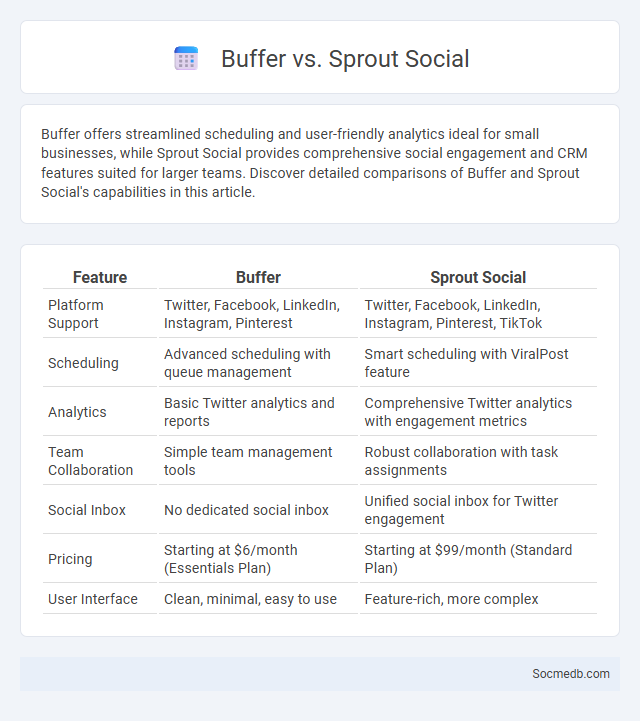
Photo illustration: Buffer vs Sprout Social
Buffer offers streamlined scheduling and user-friendly analytics ideal for small businesses, while Sprout Social provides comprehensive social engagement and CRM features suited for larger teams. Discover detailed comparisons of Buffer and Sprout Social's capabilities in this article.
Table of Comparison
| Feature | Buffer | Sprout Social |
|---|---|---|
| Platform Support | Twitter, Facebook, LinkedIn, Instagram, Pinterest | Twitter, Facebook, LinkedIn, Instagram, Pinterest, TikTok |
| Scheduling | Advanced scheduling with queue management | Smart scheduling with ViralPost feature |
| Analytics | Basic Twitter analytics and reports | Comprehensive Twitter analytics with engagement metrics |
| Team Collaboration | Simple team management tools | Robust collaboration with task assignments |
| Social Inbox | No dedicated social inbox | Unified social inbox for Twitter engagement |
| Pricing | Starting at $6/month (Essentials Plan) | Starting at $99/month (Standard Plan) |
| User Interface | Clean, minimal, easy to use | Feature-rich, more complex |
Introduction to Buffer, Sprout Social, and Social Listening
Buffer and Sprout Social are leading social media management platforms that streamline content scheduling, audience engagement, and performance analytics to boost your online presence effectively. Social listening tools enhance these platforms by monitoring brand mentions, tracking industry trends, and analyzing customer sentiment across multiple channels. Leveraging Buffer, Sprout Social, and advanced social listening enables you to craft targeted strategies that increase engagement and drive meaningful business growth.
Key Features Overview: Buffer vs Sprout Social
Buffer offers intuitive scheduling tools, social media analytics, and team collaboration features designed for small to medium-sized businesses. Sprout Social provides advanced social listening, customer relationship management (CRM), and comprehensive reporting suited for larger enterprises and marketing agencies. Both platforms support multiple social channels, but Sprout Social excels in in-depth audience engagement and real-time interaction tracking.
What is Social Listening?
Social listening is the process of monitoring digital conversations and analyzing online mentions of a brand, product, or industry across social media platforms. It involves tracking keywords, hashtags, and sentiment to gain insights into customer opinions, market trends, and competitive positioning. Businesses use social listening tools to improve customer engagement, manage reputation, and inform marketing strategies based on real-time data.
Social Listening vs Social Media Management Tools
Social listening tools analyze online conversations and monitor brand sentiment across social media platforms, enabling businesses to identify trends, customer feedback, and potential crises in real-time. Social media management tools facilitate scheduling, publishing, and managing content, along with engagement tracking and analytics for multiple accounts. Combining both tools enhances a brand's ability to respond proactively and optimize marketing strategies based on comprehensive audience insights.
Buffer: Strengths and Limitations
Buffer excels in social media management with features like intuitive scheduling, comprehensive analytics, and seamless team collaboration, enhancing your content strategy and engagement efficiency. Its strengths include a clean interface and integration with major social platforms such as Facebook, Twitter, and Instagram. Limitations consist of fewer advanced automation options compared to competitors and restricted customization in lower-tier plans, potentially impacting scalability for growing businesses.
Sprout Social: Strengths and Limitations
Sprout Social excels in providing comprehensive social media management through robust analytics, user-friendly scheduling, and powerful engagement tools tailored for businesses of all sizes. Its strengths lie in detailed reporting, seamless collaboration features, and a centralized inbox that streamlines interaction with your audience. However, the platform's higher pricing and limited customization options may pose challenges for smaller teams or those seeking more flexible integrations.
Pricing Comparison: Buffer vs Sprout Social
Buffer offers straightforward pricing plans starting at $6 per month for individuals, with its Pro plan supporting up to 8 social accounts and 100 scheduled posts. Sprout Social's pricing is higher, beginning at $249 per user per month, but includes advanced features like in-depth analytics, CRM tools, and social listening. Budget-conscious users may prefer Buffer for essential scheduling needs, while enterprises seeking robust analytics and customer engagement tools often choose Sprout Social despite the premium cost.
Integration Capabilities and Supported Platforms
Social media platforms offer extensive integration capabilities that enable seamless connection with third-party applications, enhancing your digital marketing and management strategies. Supported platforms such as Facebook, Instagram, Twitter, LinkedIn, and TikTok provide APIs and tools for automated posting, data analytics, and customer engagement. Leveraging these integrations boosts efficiency and allows you to consolidate your social media presence across multiple channels.
Best Use Cases for Each Tool
Instagram excels in visual storytelling, making it ideal for brands in fashion, travel, and food to showcase products through high-quality images and short videos. LinkedIn is the premier platform for professional networking, B2B marketing, and thought leadership, enabling businesses to share industry insights and recruit top talent. Twitter serves well for real-time updates, customer engagement, and influencer interactions, offering rapid communication through concise messages and trending hashtags.
Choosing the Right Tool for Your Social Strategy
Selecting the right social media platform is crucial for maximizing engagement and reaching your target audience effectively. Consider factors like user demographics, content format compatibility, and analytics features to align the tool with your strategic goals. Your choice directly impacts brand visibility, interaction rates, and ROI in your social media campaigns.
 socmedb.com
socmedb.com